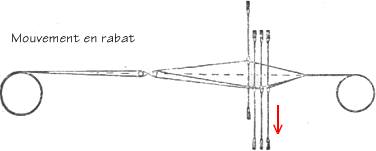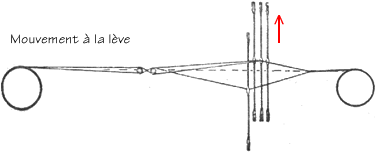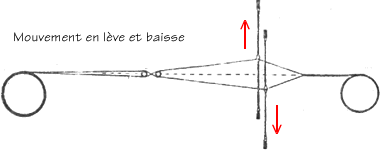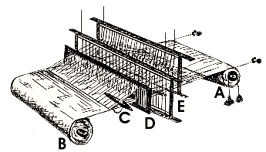- Home
- Resurrection ▾
-
Learn ▾
- Free library
- Glossary
- Documents
- Initiation
-
Shaped fabrics
- Introduction
- Popularization
- Definitions
- Le métier de façonné
- Principes du façonné
- Mécaniques de façonné
- Le jeu des crochets
- Les cartons
- Chaîne des cartons
- Mécanique 104 en détail
- Pour en finir
- Montage façonné
- Empoutage 1/3
- Empoutage 2/3
- Empoutage 3/3
- Punching, hanging and dip
- Autres façonnés
- Façonnés et Islam
-
Cours de tissage 1912
- Bâti d'un métier
- Le rouleau arrière
- Les bascules
- Formation du pas
- Position de organes
- Mécanique 104 Jacquard
- Fonctionnement 104
- Lisage des cartons
- Le battant du métier
- Le régulateur
- Réduction et régulateur
- Mise au métier d'une chaîne
- Mise en route du métier
- Navettes à soie
- Battage
- Ourdissage mécanique
- Préparation chaînes et trames
- Equipment ▾
- Chronicles ▾
- Fabrics ▾
- Techniques ▾
- Culture ▾
- Language ▾

3 / - by lowering the threads which must pass below the weft while those who are to pass above are stationary. This third method is called downward movement and is applied only in the weaving of velvet.

2 / - by raising the threads which must pass over the weft while those which are to lie below remain stationary. This means of forming the shed receives the name of movement at the rising, it is applied to the manufacture of the majority of the fabrics.

To execute a fabric the threads of the warp must be divided for each insertion of the weft into two layers between which the shuttle responsible for depositing the weft is sliding. The angle formed by the two layers is referred to as shed, (C) and the proportion of the yarns that composes the two layers varies according to the weave used. For example in taffeta or linen weave, each layer consists of half of the threads, in the satin of 8, 1/8 th.
Shed formation can be achieved in three different ways:
1 / - by raising the threads which are to pass over the weft, while those which are to be below are descended by a quantity generally equal. This principle, called lift and drop movement, has the advantage of actuating the threads while maintaining the two plies under a substantially constant tension during operation of the loom. It is mainly applied to the making of fabrics in which the threads cross by half.

To activate the warp yarns are used elements called healds. The healds are used for the manufacture of plain fabrics and held eyelets for the manufacture of figured fabrics. The healds are grouped in shaft frames the whole of which forms the harness (E).
In front of the harness, all the yarns pass through the reed (D), a mechanical member formed of very thin and polished steel blades (teeth), whose function is to distribute the warp yarns in the width of the fabric ; To serve as a guide to the shuttle and to pack the weft, the reed is supported by the hand slay.
The interval between the harness and the fabric is called shed (C); It is in this interval that is variable as a dimension that the reed driven by the hand slay moves.
As the weaving progresses, the fabric is wound on a large wooden cylinder called a beam of cloth (B) arranged in front of the loom. This beam is driven in a very slow rotational movement by an apparatus consisting essentially of toothed wheels called a take up motion (the scandinavian looms, generally do not have a take up motion). The non-wrapped fabric part which is stretched forward is called the "façure" (B to C).

In the looms, the yarns which are arranged in the direction of the length of the fabric are referred to as the warp. This warp, whose number of threads varies according to the kind, the quality of the fabric to be executed is prepared on a machine called warper, then folded, that is to say, wound on a large wooden cylinder called chain roll or beam, which Is placed on two supports fixed to the back of the loom (A).
The unwinding warp is extended in the length of the loom and the interval between this warp beam and the harness of the loom takes the name of length (A to E). In the length, all the threads are crossed, that is to say they are crossed on two wooden sticks called crossing rods in order to preserve the place given to them at the warping and to enable the weaver to find easily the location of a broken yarn during weaving. This lease is conventionally effected in the following manner: the odd threads are passed below the first crossing rod and above the second crossing rod and the even yarns are arranged above the first crossing rod and below the second crossing rod, the first crossing rod being that located behind the loom, the closest to the warp beam A.
Some fabrics require the use of several warps wound on separate beams placed at the back of the loom and constituting as many layers of yarns, the first being that of the top.
In order to execute a fabric, the warp yarns are separated into two layers forming an angle sufficiently open so that the weft can be inserted therein by means of the shuttle, the threads alternately passing over the weft , or below, according to an order determined by the weave.

Introduction
Here is a description of what weaving is, which will help all those who want to try the adventure to acquire the necessary bases to set foot in the stirrup.